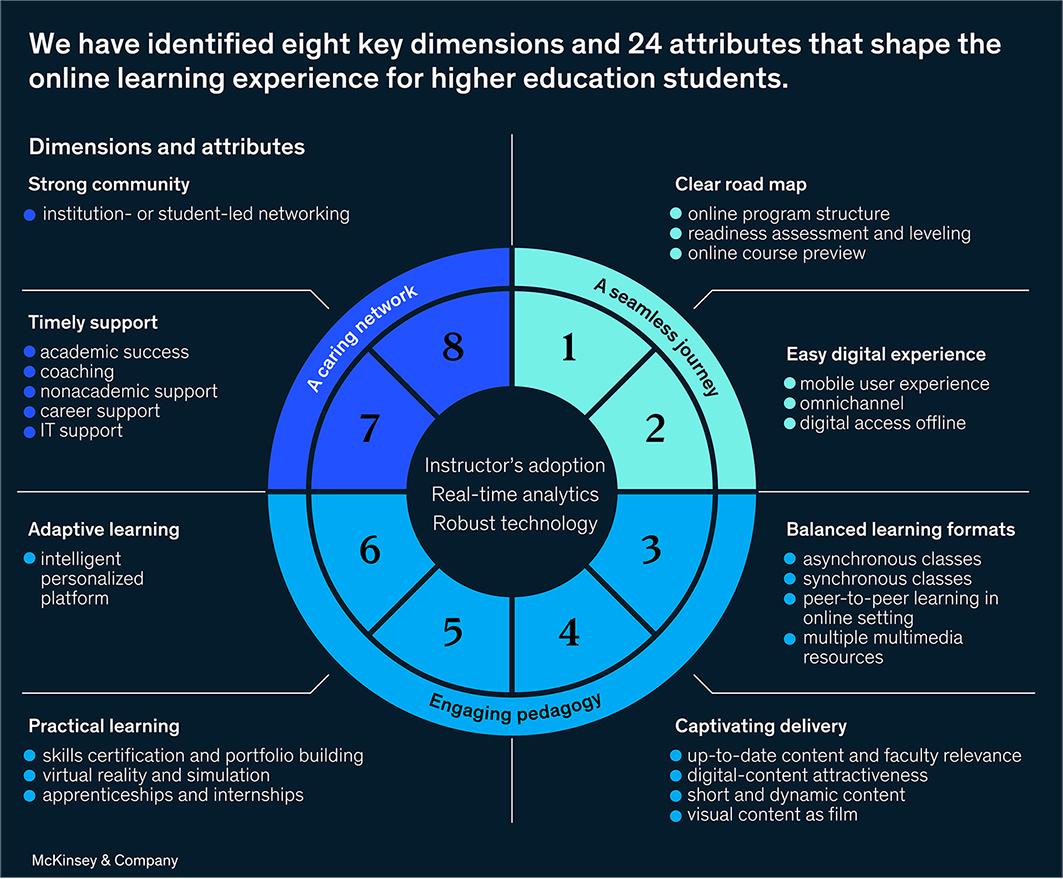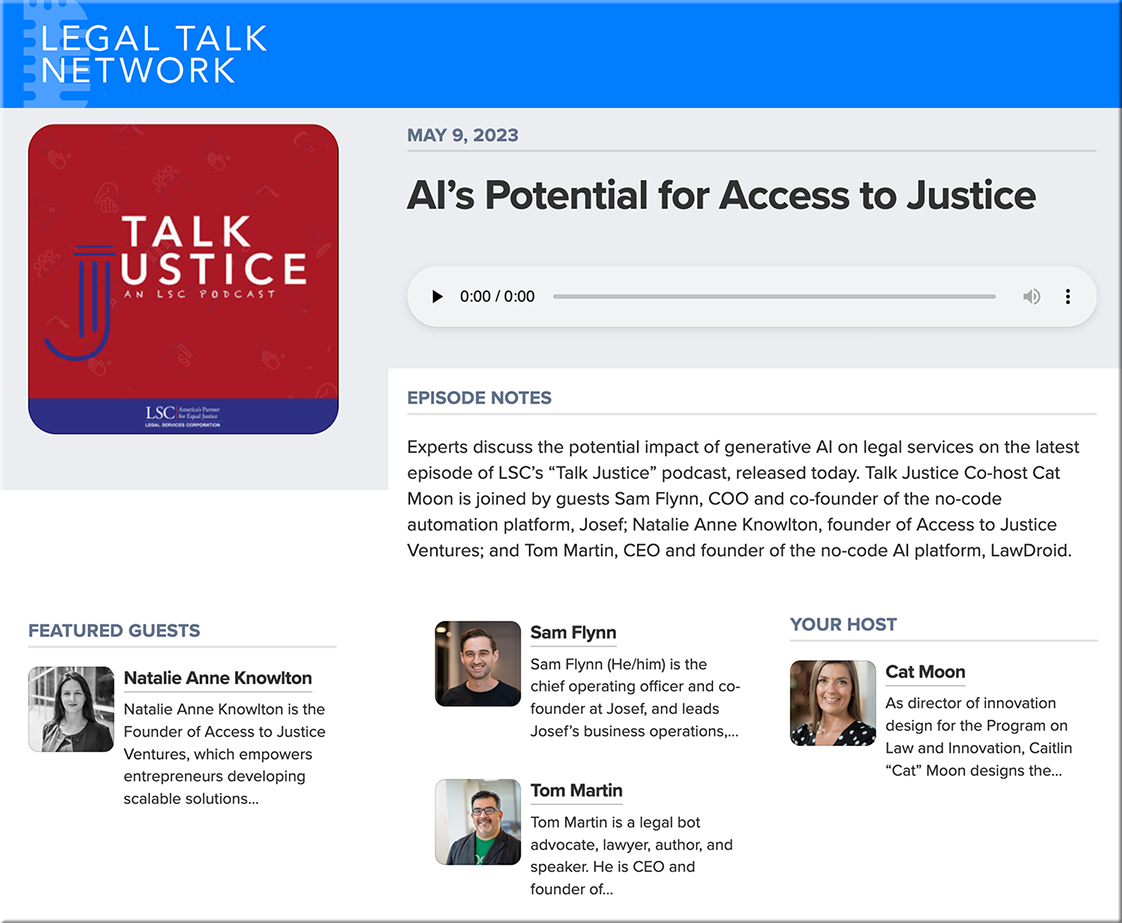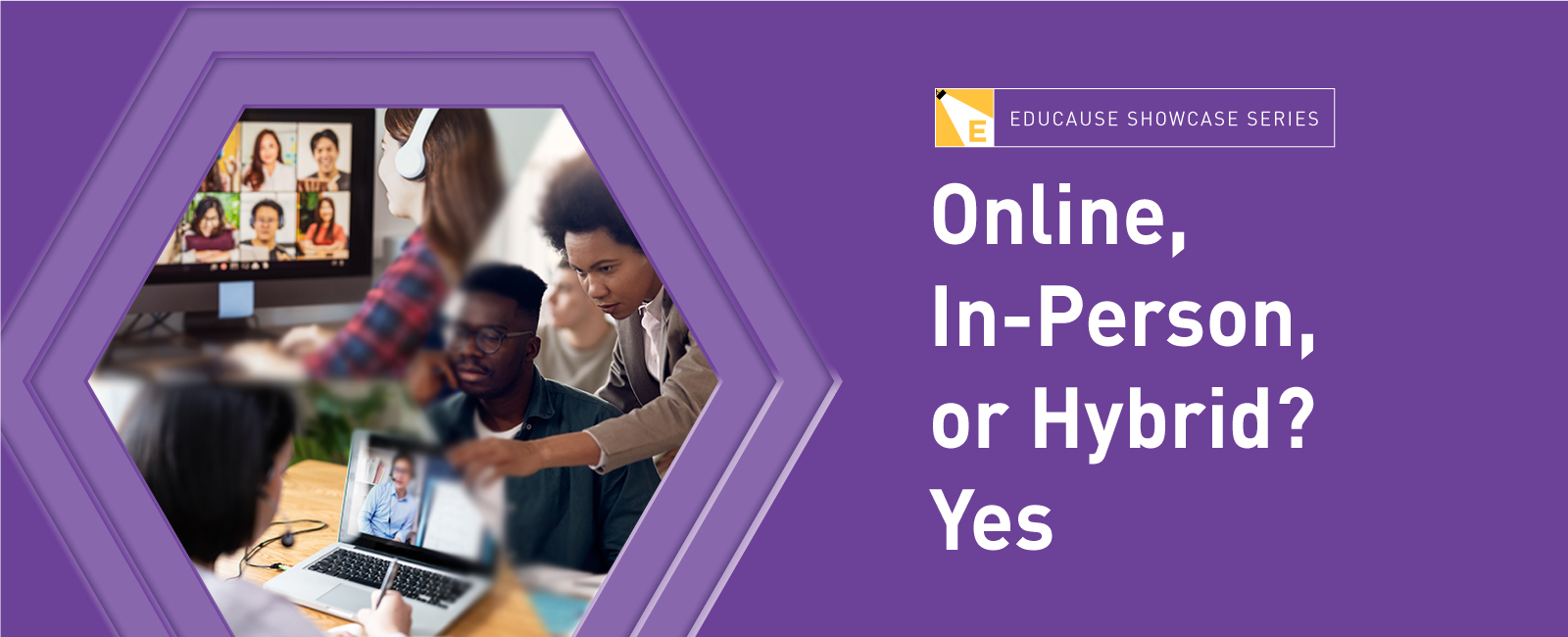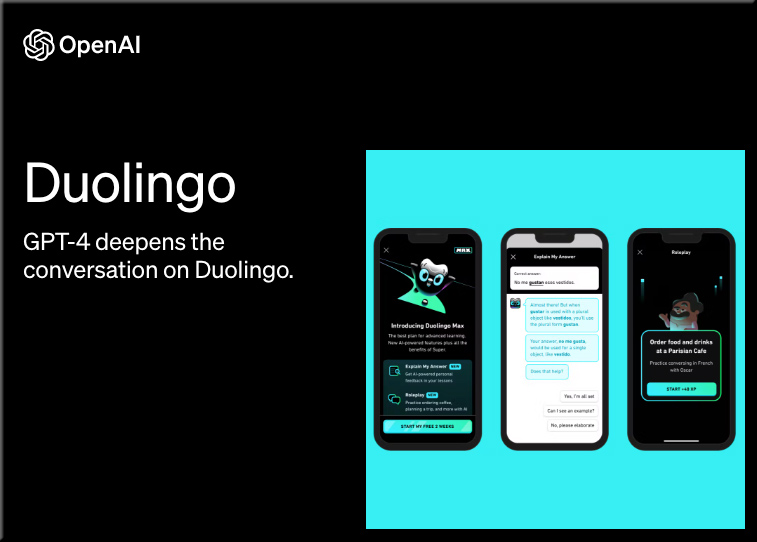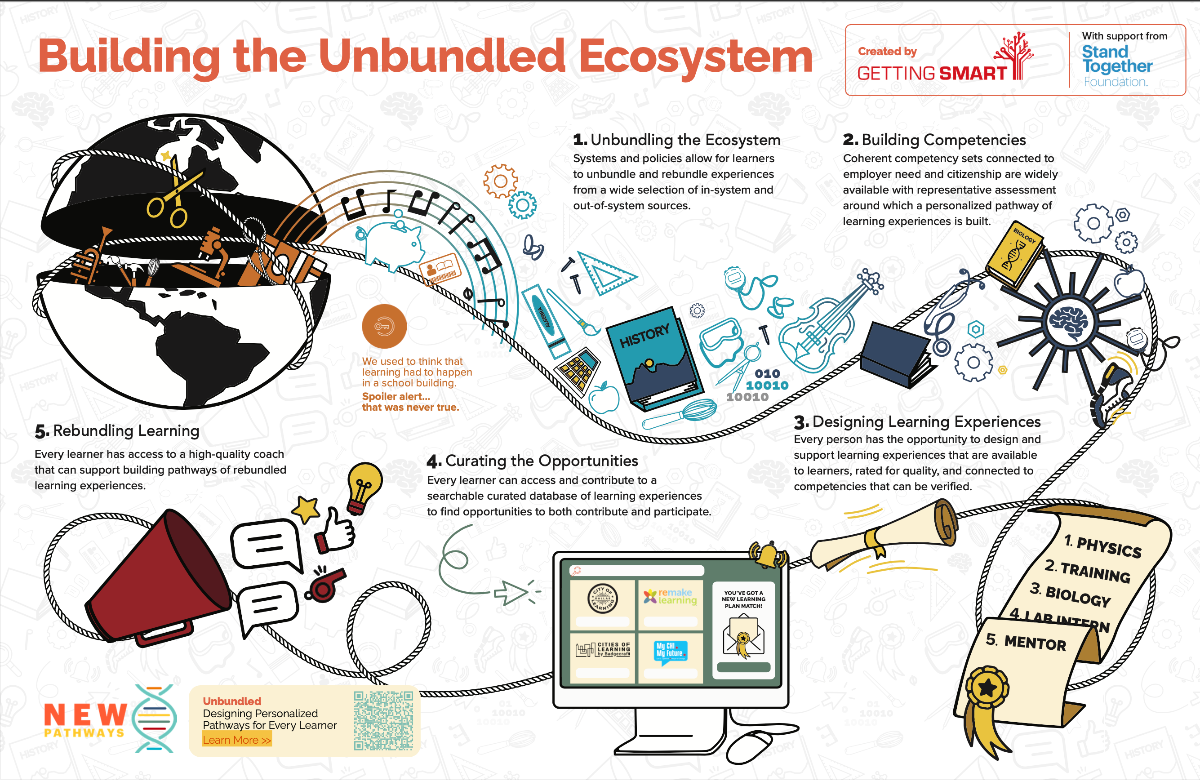What do higher education students want from online learning? — from mckinsey.com by Felipe Child, Marcus Frank, Jonathan Law, and Jimmy Sarakatsannis
What over 7000 students across 17 countries value most in online education
AI-driven Legal Apprenticeships — from thebrainyacts.beehiiv.com by Josh Kubicki
Excerpts:
My hypothesis and research suggest that as bar associations and the ABA begin to recognize the on-going systemic issues of high-cost legal education, growing legal deserts (where no lawyer serves a given population), on-going and pervasive access to justice issues, and a public that is already weary of the legal system – alternative options that are already in play might become more supported.
What might that look like?
The combination of AI-assisted education with traditional legal apprenticeships has the potential to create a rich, flexible, and engaging learning environment. Here are three scenarios that might illustrate what such a combination could look like:
-
- Scenario One – Personalized Curriculum Development
- Scenario Two – On-Demand Tutoring and Mentoring
- Scenario Three – AI-assisted Peer Networks and Collaborative Learning:
Why Companies Are Vastly Underprepared For The Risks Posed By AI — from forbes.com by
Accuracy, bias, security, culture, and trust are some of the risks involved
Excerpt:
We know that there are challenges – a threat to human jobs, the potential implications for cyber security and data theft, or perhaps even an existential threat to humanity as a whole. But we certainly don’t yet have a full understanding of all of the implications. In fact, a World Economic Forum report recently stated that organizations “may currently underappreciate AI-related risks,” with just four percent of leaders considering the risk level to be “significant.”
A survey carried out by analysts Baker McKenzie concluded that many C-level leaders are over-confident in their assessments of organizational preparedness in relation to AI. In particular, it exposed concerns about the potential implications of biased data when used to make HR decisions.
AI & lawyer training: How law firms can embrace hybrid learning & development — thomsonreuters.com
A big part of law firms’ successful adaptation to the increased use of ChatGPT and other forms of generative AI, may depend upon how firmly they embrace online learning & development tools designed for hybrid work environments
Excerpt:
As law firms move forward in using of advanced artificial intelligence such as ChatGPT and other forms of generative AI, their success may hinge upon how they approach lawyer training and development and what tools they enlist for the process.
One of the tools that some law firms use to deliver a new, multi-modal learning environment is an online, video-based learning platform, Hotshot, that delivers more than 250 on-demand courses on corporate, litigation, and business skills.
Ian Nelson, co-founder of Hotshot, says he has seen a dramatic change in how law firms are approaching learning & development (L&D) in the decade or so that Hotshot has been active. He believes the biggest change is that 10 years ago, firms hadn’t yet embraced the need to focus on training and development.
From DSC:
Heads up law schools. Are you seeing/hearing this!?
- Are we moving more towards a lifelong learning model within law schools?
- If not, shouldn’t we be doing that?
- Are LLM programs expanding quickly enough? Is more needed?
Legal tech and innovation: 3 ways AI supports the evolution of legal ops — from lexology.com
Excerpts:
- Simplified legal spend analysis
- Faster contract review
- Streamlined document management

.
Homeschool Talks is an informative podcast about all things homeschooling.
Changed by Our Journey: Engaging Students through Simulive Learning — from er.educause.edu by Lisa Lenze and Megan Costello
In this article, an instructor explains how she took an alternative approach to teaching—simulive learning—and discusses the benefits that have extended to her in-person classrooms.
Excerpts:
Mustering courage, Costello devised a novel way to (1) share the course at times other than when it was regularly scheduled and (2) fully engage with her students in the chat channel during the scheduled class meeting time. Her solution, which she calls simulive learning, required her to record her lectures and watch them with her students. (Courageous, indeed!)
Below, Costello and I discuss what simulive learning looks like, how it works, and how Costello has taken her version of remote synchronous teaching forward into current semesters.
Megan Costello: I took a different approach to remote synchronous online learning at the start of the pandemic. Instead of using traditional videoconferencing software to hold class, I prerecorded, edited, and uploaded videos of my lectures to a streaming website. This website allowed me to specify a time and date to broadcast my lectures to my students. Because the lectures were already prepared, I could watch and participate in the chat with my students as we encountered the materials together during the scheduled class time. I drove conversations in chat, asked questions, and got students engaged as we covered materials for the day. The students had my full attention.
Trend No. 3: The business model faces a full-scale transformation — from www2.deloitte.com by Cole Clark, Megan Cluver, and Jeffrey J. Selingo
The traditional business model of higher education is broken as institutions can no longer rely on rising tuition among traditional students as the primary driver of revenue.
Excerpt:
Yet the opportunities for colleges and universities that shift their business model to a more student-centric one, serving the needs of a wider diversity of learners at different stages of their lives and careers, are immense. Politicians and policymakers are looking for solutions to the demographic cliff facing the workforce and the need to upskill and reskill generations of workers in an economy where the half-life of skills is shrinking. This intersection of needs—higher education needs students; the economy needs skilled workers—means that colleges and universities, if they execute on the right set of strategies, could play a critical role in developing the workforce of the future. For many colleges, this shift will require a significant rethinking of mission and structure as many institutions weren’t designed for workforce development and many faculty don’t believe it’s their job to get students a job. But if a set of institutions prove successful on this front, they could in the process improve the public perception of higher education, potentially leading to more political and financial support for growing this evolving business model in the future.
Also see:
Trend No. 2: The value of the degree undergoes further questioning — from www2.deloitte.com by Cole Clark, Megan Cluver, and Jeffrey J. Selingo
The perceived value of higher education has fallen as the skills needed to keep up in a job constantly change and learners have better consumer information on outcomes.
Excerpt:
Higher education has yet to come to grips with the trade-offs that students and their families are increasingly weighing with regard to obtaining a four-year degree.
…
But the problem facing the vast majority of colleges and universities is that they are no longer perceived to be the best source for the skills employers are seeking. This is especially the case as traditional degrees are increasingly competing with a rising tide of microcredentials, industry-based certificates, and well-paying jobs that don’t require a four-year degree.
Trend No. 1: College enrollment reaches its peak — from www2.deloitte.com by Cole Clark, Megan Cluver, and Jeffrey J. Selingo
Enrollment rates in higher education have been declining in the United States over the years as other countries catch up.
Excerpt:
Higher education in the United States has only known growth for generations. But enrollment of traditional students has been falling for more than a decade, especially among men, putting pressure both on the enrollment pipeline and on the work ecosystem it feeds. Now the sector faces increased headwinds as other countries catch up with the aggregate number of college-educated adults, with China and India expected to surpass the United States as the front runners in educated populations within the next decade or so.
Plus the other trends listed here >>
Also related to higher education, see the following items:
Number of Colleges in Distress Is Up 70% From 2012 — from bloomberg.com by Nic Querolo (behind firewall)
More schools see falling enrollement and tuition revenue | Small private, public colleges most at risk, report show
About 75% of students want to attend college — but far fewer expect to actually go — from highereddive.com by Jeremy Bauer-Wolf
There Is No Going Back: College Students Want a Live, Remote Option for In-Person Classes — from campustechnology.com by Eric Paljug
Excerpt:
Based on a survey of college students over the last three semesters, students understand that remotely attending a lecture via remote synchronous technology is less effective for them than attending in person, but they highly value the flexibility of this option of attending when they need it.
Future Prospects and Considerations for AR and VR in Higher Education Academic Technology — from er.educause.edu by Owen McGrath, Chris Hoffman and Shawna Dark
Imagining how the future might unfold, especially for emerging technologies like AR and VR, can help prepare for what does end up happening.
Black Community College Enrollment is Plummeting. How to Get Those Students Back — from the74million.org by Karen A. Stout & Francesca I. Carpenter
Stout & Carpenter: Schools need a new strategy to bolster access for learners of color who no longer see higher education as a viable pathway
As the Level Up coalition reports ,“the vast majority — 80% — of Black Americans believe that college is unaffordable.” This is not surprising given that Black families have fewer assets to pay for college and, as a result, incur significantly more student loan debt than their white or Latino peers. This is true even at the community college level. Only one-third of Black students are able to earn an associate degree without incurring debt.
Repairing Gen Ed | Colleges struggle to help students answer the question, ‘Why am I taking this class?’ — from chronicle.com by Beth McMurtrie
Students Are Disoriented by Gen Ed. So Colleges Are Trying to Fix It.
Excerpts:
Less than 30 percent of college graduates are working in a career closely related to their major, and the average worker has 12 jobs in their lifetime. That means, he says, that undergraduates must learn to be nimble and must build transferable skills. Why can’t those skills and ways of thinking be built into general education?
…
“Anyone paying attention to the nonacademic job market,” he writes, “will know that skills, rather than specific majors, are the predominant currency.”
Micro-credentials Survey. 2023 Trends and Insights. — from holoniq.com
HolonIQ’s 2023 global survey on micro-credentials
3 Keys to Making Microcredentials Valid for Learners, Schools, and Employers — from campustechnology.com by Dave McCool
To give credentials value in the workplace, the learning behind them must be sticky, visible, and scalable.
Positive Partnership: Creating Equity in Gateway Course Success — from insidehighered.com by Ashley Mowreader
The Gardner Institute’s Courses and Curricula in Urban Ecosystems initiative works alongside institutions to improve success in general education courses.
American faith in higher education is declining: one poll — from bryanalexander.org by Bryan Alexander
Excerpt:
The main takeaway is that our view of higher education’s value is souring. Fewer of us see post-secondary learning as worth the cost, and now a majority think college and university degrees are no longer worth it: “56% of Americans think earning a four-year degree is a bad bet compared with 42% who retain faith in the credential.”
…
Again, this is all about one question in one poll with a small n. But it points to directions higher ed and its national setting are headed in, and we should think hard about how to respond.
Being a new teacher is hard. Having a good mentor can help — from npr.org by Cory Turner
Excerpt:
[Besides this article’s focus on mentorship]
In March, I reported a pair of stories from Jackson, Miss., where the school district is paying for unlicensed classroom aides to go back to school and get their master’s degrees.
In April, I told the story of a remarkable idea: A new high school in San Antonio dedicated entirely to training high-schoolers in the art and science of good teaching.
From DSC:
I would add a few more items:
- Significantly reduce the impact of legislators on K-12. If they do vote on something that would impact schools, each legislator that votes on such legislation must first spend at least ___ week(s) observing in some of the schools that would be impacted before even starting to draft legislation and/or debate on the topic(s).
- Instead, turn over more control and power to the students, teachers, K12 administrators, parents, and school boards.
- Provide more choice, more control as each student can handle it.
- Stop the one-size fits all system. Instead use AI-based systems to provide more personalized learning.
- Develop more hybrid programs — but this time I’m talking mixing what we’ve known as public education with homeschooling and smaller learning pods. Let’s expand what’s included when we discuss “learning spaces.”
- Strive for a love of learning — vs. competition and developing gameplayers
- Support makerspaces, entrepreneurship, and experiments
- Speaking of experiments, I would recommend developing more bold experiments outside of the current systems.
Along the lines of potential solutions/visions, see:
Why ‘System Transformation’ Is Likely A Pipe Dream — from michaelbhorn.substack.com by Michael Horn
But I’m for System Replacement
Excerpt:
Foremost among them is this: Despite all the fancy models and white papers around what are all the levers to pull in order to transform a system, system transformation almost never happens by changing the fundamental tenets of the system itself. Instead, it comes from replacing the system with a brand-new system.
To start to understand why, consider the complicated system in which public schools find themselves. As Thomas Arnett explained, they are one part of a vast value network of federal, state, and local regulators, voters and taxpayers, parents and students, teachers, administrators, unions, curriculum providers, school vendors, public infrastructure, higher education institutions, and more.
New ideas, programs, or entities that don’t fit into these processes, priorities, and cost structures are simply not plug-compatible into that value network. They consequently get rejected, tossed to the fringe, or altered to meet the needs of the existing actors in the value network.
The 2023 Global Sentiment Survey — from donaldhtaylor.co.uk by Don Taylor
Excerpt:
This year’s Global Sentiment Survey – the tenth – paints a picture that is both familiar and unusual. In our 2020 survey report, we noted that ‘Data dominates this year’s survey’. It does so again this year, with the near 4,000 respondents showing a strong interest in AI, Skills-based talent management and Learning analytics (in positions #2, #3 and #4), all of which rely on data. The table is topped by Reskilling/upskilling, in the #1 spot for the third year running.
.
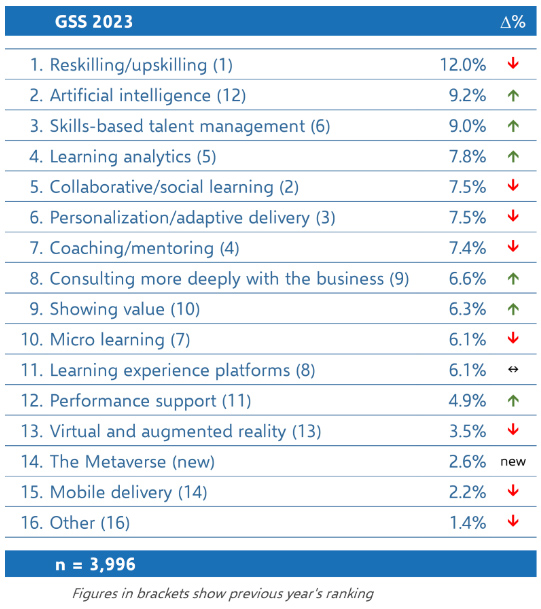
.
A New Era for Education — from linkedin.com by Amit Sevak, CEO of ETS and Timothy Knowles, President of the Carnegie Foundation for the Advancement of Teaching
Excerpt (emphasis DSC):
It’s not every day you get to announce a revolution in your sector. But today, we’re doing exactly that. Together, we are setting out to overturn 117 years of educational tradition.
…
The fundamental assumption [of the Carnegie Unit] is that time spent in a classroom equals learning. This formula has the virtue of simplicity. Unfortunately, a century of research tells us that it’s woefully inadequate.
From DSC:
It’s more than interesting to think that the Carnegie Unit has outlived its usefulness and is breaking apart. In fact, the thought is very profound.

If that turns out to be the case, the ramifications will be enormous and we will have the opportunity to radically reinvent/rethink/redesign what our lifelong learning ecosystems will look like and provide.
So I appreciate what Amit and Timothy are saying here and I appreciate their relaying what the new paradigm might look like. It goes with the idea of using design thinking to rethink how we build/reinvent our learning ecosystems. They assert:
It’s time to change the paradigm. That’s why ETS and the Carnegie Foundation have come together to design a new future of assessment.
-
- Whereas the Carnegie Unit measures seat time, the new paradigm will measure skills—with a focus on the ones we know are most important for success in career and in life.
- Whereas the Carnegie Unit never leaves the classroom, the new paradigm will capture learning wherever it takes place—whether that is in after-school activities, during a work-experience placement, in an internship, on an apprenticeship, and so on.
- Whereas the Carnegie Unit offers only one data point—pass or fail—the new paradigm will generate insights throughout the learning process, the better to guide students, families, educators, and policymakers.
I could see this type of information being funneled into peoples’ cloud-based learner profiles — which we as individuals will own and determine who else can access them. I diagrammed this back in January of 2017 using blockchain as the underlying technology. That may or may not turn out to be the case. But the concept will still hold I think — regardless of the underlying technology(ies).

For example, we are seeing a lot more articles regarding things like Comprehensive Learner Records (CLR) or Learning and Employment Records (LER; example here), and similar items.
Speaking of reinventing our learning ecosystems, also see:
The top online learning statistics in 2023 — from Devlin Peck’s Online Learning Statistics: The Ultimate List in 2023
- Worldwide, 49% of students have completed some sort of online learning
- Online learning is the fastest-growing market in the education industry – it has grown 900% since its creation in 2000
- 70% of students say online learning is better than traditional classroom learning
- The number of online learning users is expected to increase to 57 million by 2027
- 80% of businesses now offer online learning or training solutions
- 63% of students in the US engage in online learning activities daily
- Online learning can increase student and employee retention to as much as 50%
- Online learning can reduce the time needed to learn a subject by 40% to 60%
- The online learning industry is projected to be worth more than $370 billion by 2026
- Online learning and training can improve employee performance by 15% to 25%
Trade programs — unlike other areas of higher education — are in hot demand — from hechingerreport.org by Olivia Sanchez
Many young people choose to pursue short-term credentials over traditional college because they see them as a quicker and a more affordable path to a good
Excerpt:
While almost every sector of higher education is seeing fewer students registering for classes, many trade school programs are booming. Jones and his classmates, seeking certificates and other short-term credentials, not associate degrees, are part of that upswing.
Mechanic and repair trade programs saw an enrollment increase of 11.5 percent from spring 2021 to 2022, according to the National Student Clearinghouse. Enrollment in construction trades courses increased by 19.3 percent, while culinary program enrollment increased 12.7 percent, according to the Clearinghouse.
Death of a Traditional Lecture — from by Abby L Kalkstein, PhD, and Justin L. Rheubert
Excerpts:
However, some of the digital/remote content is better than what we can provide in the physical classroom. For example, in a biology course, instructors can watch students interact with thousands of 3D models, such as those found on Sketchfab or virtual programs such as BioDigital. Additionally, students can follow along virtually as instructors point out different structures. This approach is not possible in a physical classroom unless each student has their own physical model or they bring their computers.
…
We should welcome the unfamiliarity of new and blended course designs and strive to build courses based on the best approach for the content regardless of the format, rather than revert to the comfort of analog lecturing.
How College Students Say They Learn Best— from insidehighered.com by Colleen Flaherty
In a new Student Voice survey, students share their preferences for class format, active learning strategies and note-taking. Interactive lectures and case studies are especially popular.
OPM Market Landscape And Dynamics: Spring 2023 Updates — from philhillaa.com by Phil Hill
Excerpt:
OPM Market Landscape
- Market valuations of publicly-traded OPM companies have continued to drop, with 2U/edX, Coursera, and Keypath all down 75% or more from March 2021.
- Pearson tapped out of the market, agreeing to sell its OPM business to private equity firm Regent.
- Zovio is no more. It has ceased to be.
- FutureLearn sold the remnants of its business to a for-profit system, and it now has the most obnoxious website of any OPM provider, past or present.
- Byju’s, which (according to multiple media accounts) had been considering an acquisition of 2U/edX or Coursera, abandoned these plans to go off and deal with its own financial crisis.
- Noodle acquired South Africa-based Hubble Studios.
- The Government Accountability Office (GAO) released a report on the OPM market, triggering (but not causing) official efforts to make massive regulatory changes.
Harvard and MIT Launch Nonprofit to Increase College Access — from edsurge.com by Jeffrey R. Young
The effort is backed by the $800 million sale of the online platform edX in 2021.
Excerpt:
What would you do if you had $800 million to build a new nonprofit to support innovation in online learning?
That’s the privileged question that officials at Massachusetts Institute of Technology and Harvard University have been mulling over for the last two years, and late last month they announced some answers.
The result is a new nonprofit named Axim Collaborative, and its focus will be on serving learners that higher education has historically left behind.
As the group’s new CEO, Stephanie Khurana, put it in an interview with EdSurge this week: “The focus of the mission is to really help postsecondary completion and issues of economic mobility.”
California helps college students cut their debt by paying them to help their communities — from hechingerreport.org by Gail Cornwall
Inspired by service programs from earlier eras, the College Corps program puts low-income, first-generation students to work in education, food insecurity and climate mitigation
‘The reckoning is here’: More than a third of community college students have vanished — from hechingerreport.org by Jon Marcus
Among those who do enroll, red tape and a lack of support are crushing their ambition
The Importance of Student Agency and Self-Direction — from evolllution.com by Cathrael Kazin
Excerpt:
The traditional higher education model is not a one-size-fits all. And students are increasingly calling for adaptability and flexibility to meet their needs. The focus on student agency is a tactic that many leaders can leverage when looking to support these needs and thrive moving forward. In this interview, Cathrael Kazin discusses the need for student agency and self-direction, the challenges that come with it and how to improve student retention and success.
What Is the Secret Sauce for Deeper Learning? — from cultofpedagogy.com by Jennifer Gonzalez
Excerpt:
One place that was a consistent source of deep learning was what Fine and Mehta referred to as “the periphery,” elective classes like art and robotics and extracurriculars like debate and athletics that are outside of what we consider to be the core academic classes. “Nobody talks very much about what’s going on in those spaces,” Fine says, “and yet they were the places where we saw the richest learning happening.” In these spaces, much of what they call the “grammar” of school is different: Students are there by choice, they have opportunities for apprenticeship and leadership, they can specialize in a subdomain of the field, and there’s usually a real product being produced for an authentic audience.
In the book, the authors used a school theater program as an example of this kind of learning at the periphery.

HOW DUOLINGO’S AI LEARNS WHAT YOU NEED TO LEARN — from spectrum.ieee.org by Klinton Bicknell, Claire Brust, and Burr Settles
The AI that powers the language-learning app today could disrupt education tomorrow
Excerpt:
It’s lunchtime when your phone pings you with a green owl who cheerily reminds you to “Keep Duo Happy!” It’s a nudge from Duolingo, the popular language-learning app, whose algorithms know you’re most likely to do your 5 minutes of Spanish practice at this time of day. The app chooses its notification words based on what has worked for you in the past and the specifics of your recent achievements, adding a dash of attention-catching novelty. When you open the app, the lesson that’s queued up is calibrated for your skill level, and it includes a review of some words and concepts you flubbed during your last session.
The AI systems we continue to refine are necessary to scale the learning experience beyond the more than 50 million active learners who currently complete about 1 billion exercises per day on the platform.
Although Duolingo is known as a language-learning app, the company’s ambitions go further. We recently launched apps covering childhood literacy and third-grade mathematics, and these expansions are just the beginning. We hope that anyone who wants help with academic learning will one day be able to turn to the friendly green owl in their pocket who hoots at them, “Ready for your daily lesson?”
Also relevant/see:
Duolingo turned to OpenAI’s GPT-4 to advance the product with two new features: Role Play, an AI conversation partner, and Explain my Answer, which breaks down the rules when you make a mistake, in a new subscription tier called Duolingo Max.
“We wanted AI-powered features that were deeply integrated into the app and leveraged the gamified aspect of Duolingo that our learners love,” says Bodge.
Also relevant/see:
The following is a quote from Donald Clark’s posting on LinkedIn.com today:
The whole idea of AI as a useful teacher is here. Honestly it’s astounding. They have provided a Socratic approach to an algebra problem that is totally on point. Most people learn in the absence of a teacher or lecturer. They need constant scaffolding, someone to help them move forward, with feedback. This changes our whole relationship with what we need to know, and how we get to know it. Its reasoning ability is also off the scale.
We now have human teachers, human learners but also AI teachers and AI that learns. It used to be a diad, it is now a tetrad – that is the basis of the new pedAIgogy.
Personalised, tutor-led learning, in any subject, anywhere, at any time for anyone. That has suddenly become real.
Also relevant/see:
Introducing Duolingo Max, a learning experience powered by GPT-4 — from blog.duolingo.com
Excerpts:
We believe that AI and education make a great duo, and we’ve leveraged AI to help us deliver highly-personalized language lessons, affordable and accessible English proficiency testing, and more. Our mission to make high-quality education available to everyone in the world is made possible by advanced AI technology.
Explain My Answer offers learners the chance to learn more about their response in a lesson (whether their answer was correct or incorrect!)
…
Roleplay allows learners to practice real-world conversation skills with world characters in the app.
Introducing Q-Chat, the world’s first AI tutor built with OpenAI’s ChatGPT — from quizlet.com by Lex Bayer
Excerpt:
Modeled on research demonstrating that the most effective form of learning is one-on-one tutoring1, Q-Chat offers students the experience of interacting with a personal AI tutor in an effective and conversational way. Whether they’re learning French vocabulary or Roman History, Q-Chat engages students with adaptive questions based on relevant study materials delivered through a fun chat experience. Pulling from Quizlet’s massive educational content library and using the question-based Socratic method to promote active learning, Q-Chat has the ability to test a student’s knowledge of educational content, ask in-depth questions to get at underlying concepts, test reading comprehension, help students learn a language and encourage students on healthy learning habits.
Does ‘Flipped Learning’ Work? A New Analysis Dives Into the Research — from edsurge.com by Jeffrey R. Young
Excerpt:
The researchers do think that flipped learning has merit — if it is done carefully. They end their paper by presenting a model of flipped learning they refer to as “fail, flip, fix and feed,” which they say applies the most effective aspects they learned from their analysis. Basically they argue that students should be challenged with a problem even if they can’t properly solve it because they haven’t learned the material yet, and then the failure to solve it will motivate them to watch the lecture looking for the necessary information. Then classroom time can be used to fix student misconceptions, with a mix of a short lecture and student activities. Finally, instructors assess the student work and give feedback.
From DSC:
Interesting. I think their “fail, flip, fix and feed” method makes sense.
Also, I do think there’s merit in presenting information ahead of time so that students can *control the pace* of listening/processing/absorbing what’s being relayed. (This is especially helpful for native language differences.) If flipped learning would have been a part of my college experience, it would have freed me from just being a scribe. I could have tried to actually process the information while in class.
Unbundled: Designing Personalized Pathways for Every Learner — from gettingsmart.com by Nate McClennen “with contributions from the Getting Smart team and numerous friends and partners in the field”
Excerpts:
In this publication, we articulate the critical steps needed to unbundle the learning ecosystem, build core competencies, design learning experiences, curate new opportunities, and rebundle these experiences into coherent pathways.
.
Vision
Every learner deserves an unlimited number of unbundled opportunities to explore, engage, and define experiences that advance their progress along a co-designed educational pathway. Each pathway provides equitable and personalized access to stacked learning experiences leading to post-secondary credentials and secure family-sustaining employment. Throughout the journey, supportive coaches focus on helping learners build skills to navigate with agency. In parallel, learners develop foundational skills (literacy, math), technical skills, and durable skills and connect these to challenging co-designed experiences. The breadth and depth of experiences increase over time, and, in partnership, learners and coaches map progress towards reaching community-defined goals. This vision is only enabled by an unbundled learning ecosystem.
…
Recommendations
Solutions already exist in the ecosystem and need to be combined and scaled. Funding models (like My Tech High), badging/credentialing at the competency level (like VLACS), coaching models (like Big Thought), and open ecosystems (like NH Learn Everywhere) provide an excellent foundation. Thus, building unbundled systems has already begun but needs systemic changes to become widely available and accepted.
-
-
- Build a robust competency-based system.
- Create a two-way marketplace for unbundled learning.
- Implement policy to support credit for out-of-system experiences.
- Invest in technology infrastructure for Learning and Employment Records.
- Design interoperable badging systems that connect to credentials.
-









